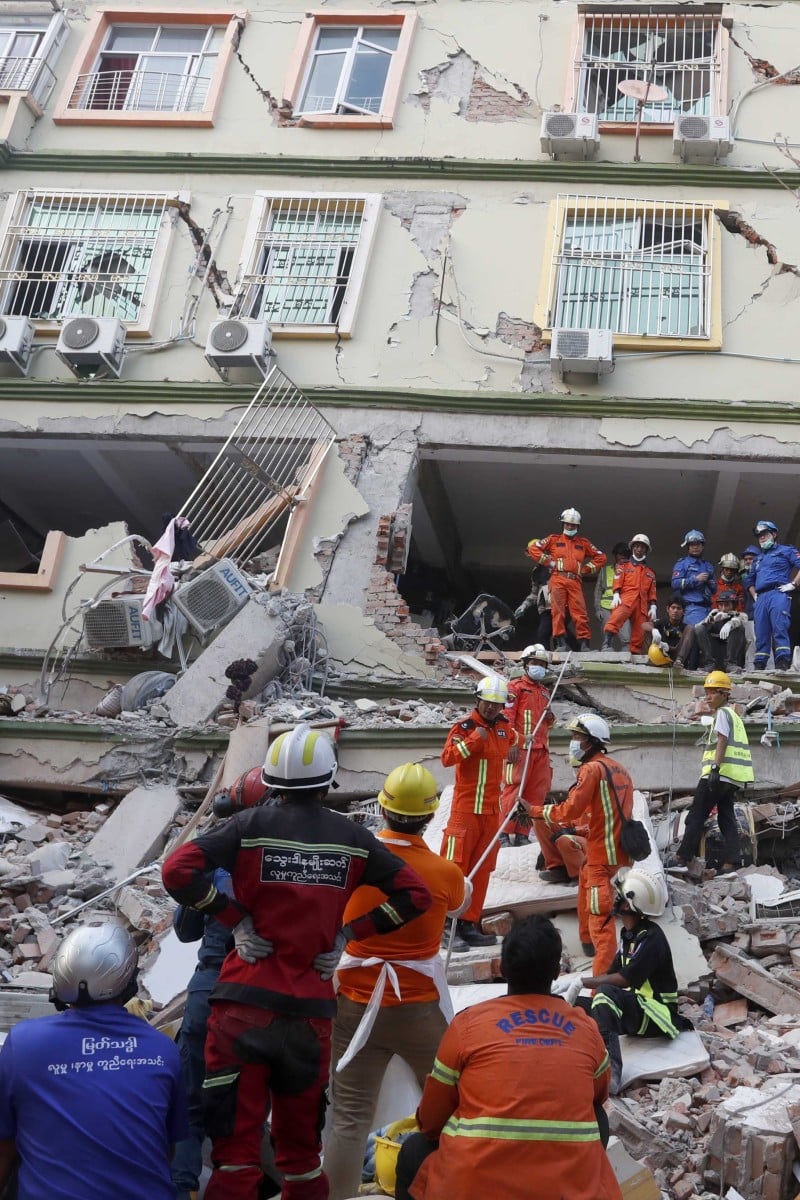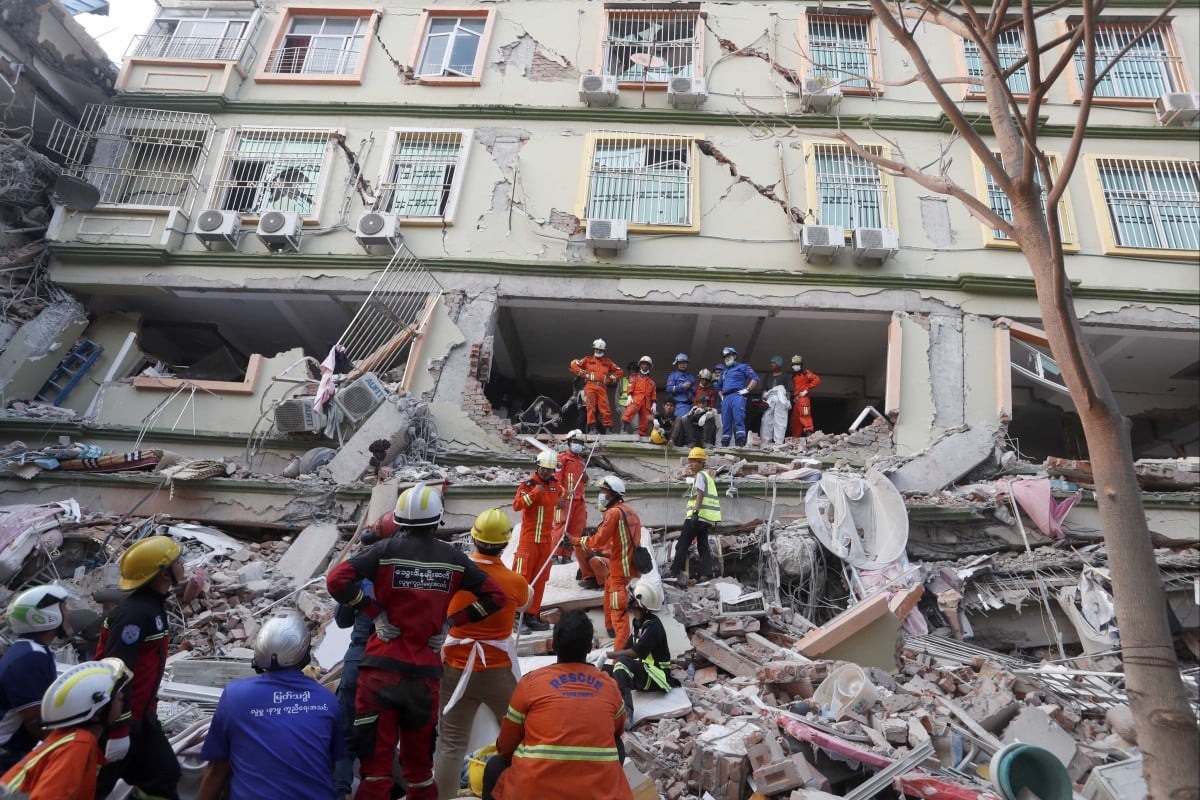
The military government has declared a partial ceasefire to allow relief efforts in, with teams from India, China, Singapore and Thailand on the ground
 Myanmar and China rescuers search for victims at the Sky Villa in Mandalay, Myanmar, 30 March 2025. Photo: EPA-EFE
Myanmar and China rescuers search for victims at the Sky Villa in Mandalay, Myanmar, 30 March 2025. Photo: EPA-EFE“The cemetery is packed with bodies. There are so many that we are cremating every three minutes,” a Sagaing resident told This Week in Asia. The frantic search for survivors continues in the parts of Myanmar hit the worst by the massive earthquake.
An estimated 1,700 people are dead, at least 3,400 injured and 300 missing as of Sunday, the military government has said. The death toll is expected to rise.
At least 17 were killed in neighbouring Thailand.
The two central Myanmar cities closest to the epicentre of Friday’s record 7.7-magnitude quake – followed moments later by a 6.4 aftershock – were Mandalay and Sagaing. Residents there said they were “on their own”. Aid has yet to reach an area where roads, airports and bridges have been damaged or destroyed.
Pulling slabs of concrete and piles of bricks with bare hands and shovels, rescuers toiled through the night in a dangerous and painstaking effort to extract people from now-flattened buildings, pagodas and shops.
There were brief moments of elation in the hellscape left by the earthquake. A woman was pulled from the rubble alive after a 30-hour ordeal in Mandalay, one of a smattering of survival stories.
But heartbreak has dominated the days since the quake; a son clasped his dying mother’s hand as she lay trapped under rubble, unable to be freed, a nursery was buried under debris, and an entire class of young monks taking a liturgy exam was believed to be entombed under the building.
As time passes, hope is fading for the untold number of people pinned under the debris of their homes and businesses.
“We are on our own,” Sagaing resident Soe Min, 24, told This Week in Asia.
“Nobody has come to help. We are using spades and our hands to move bricks to rescue people. The cemetery is packed with bodies; there are so many that we are cremating them every three minutes.”
Myanmar, one of Asia’s poorest nations and dominated by a ruthless junta for most of the last five decades, is no stranger to tragedy. It has faced deadly cyclones and decades of war. But the scale of the destruction from Friday’s quake has stunned its people, whose reflexes have been to help save their families, friends and neighbours without outside support.
“We’ve never encountered something so severe,” said one rescuer in Mandalay, requesting anonymity as the city is under the control of the hated junta.
“There are so many difficulties, limitations and risks – but we are doing as much as we can,” he added, citing blackouts, a lack of modern machinery and continuing aftershocks to remove hulking slabs of fallen concrete.
Late on Saturday, Myanmar’s junta said at least 1,644 people had been killed and more than 3,400 injured across the country – but in an already secluded nation where communications have been cut, that is expected to be far short of the true picture.
Hours after the earthquake struck, junta chief Min Aung Hlaing issued a plea for help from “any country and organisation.”
It was a rare appeal to the outside world by an army which led a coup in 2021 that plunged the country into civil war, scuttled its economy and returned the country to isolation.
Some armed groups who have fought the military called a two-week partial ceasefire to allow the rescue to continue. But there were reports on Saturday of continued shelling by junta jets and drones in other parts of the country.
China, Russia, India, Thailand and Malaysia have sent rescue teams and equipment to Myanmar. The US has also offered its support despite pulling tens of millions of aid from the country just weeks ago.
Late on Saturday, two Indian military aircraft arrived carrying 118 emergency medical personnel bound for Mandalay to establish a 60-bed treatment centre.
On Sunday, a convoy of 17 Chinese cargo trucks carrying critical shelter, emergency and medical supplies was expected to reach Mandalay.
An initial report by the UN Office for the Coordination of Humanitarian Affairs noted the severe damage or destruction of many health facilities. It warned that a “severe shortage of medical supplies is hampering response efforts, including trauma kits, blood bags, anaesthetics, assistive devices, essential medicines, and tents for health workers.”
China said it had sent more than 135 rescue personnel and pledged around US$13.8 million in aid.
Russia’s Emergencies Ministry said it had flown 120 rescuers and supplies to Yangon, and the country’s Health Ministry said Moscow had sent a medical team to Myanmar.
Teams from Singapore have already been working in Naypitaw. On Sunday, Malaysia dispatched a team of 50 personnel with trucks, search and rescue equipment, and medical supplies.